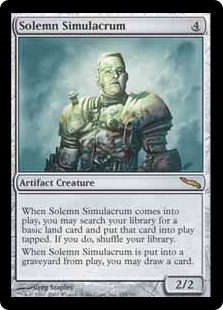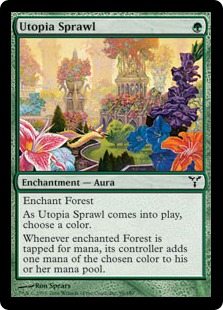Magic players love to splash extra colors in their limited decks. With the narrow, semi-random card pool you use to build your deck, the temptation is always there to add power by playing your best cards from colors your deck isn’t using otherwise. Unless your pool has no cards worth splashing, you want to consider it for all your decks. But how do you decide? What departures are necessary from common deck-building theory to get the right colors of mana? Let’s dig in!
Your ability to splash mana effectively varies from format to format. Two characteristics influence whether splashing is a viable, good idea: the speed of the format and the cards available to fix your mana.
If the format is too fast, like it was in Gatecrash, then you simply didn’t have the time to mess with playing a third or fourth color of mana. Fast formats demand streamlined one- or two-color decks. Fast formats also tend to have tight archetypes that need a critical mass of cards from a specific color or color pair. Fixing your mana in limited is inherently slow. Cards like [casthaven]Rampant Growth[/casthaven] use a card and most or all of an early turn. In a fast format, that is a luxury you cannot afford. Conversely, if the format is slow enough, you have plenty of time to draw lands and cast your fixing spells. You don’t care if your [casthaven]Evolving Wilds[/casthaven] or [casthaven]Dimir Guildgate[/casthaven] take a full turn to produce mana. Limited decks use early game cards to fill specific roles. In a slow format, one- and two-drop creatures don’t do much, so you’d rather focus on bigger plays and use the early part of your curve to set up your powerful late-game spells. Do you want to spend your early turns fixing mana and drawing extra cards? If so, splashing will be easy. If not, then you better stick to one or two colors.
The cards available to fix your mana also vary from set to set. In the slowest formats, you don’t need specific cards to help fix. You can rely on drawing enough lands that eventually you’ll hit one of your two mountains so you can end the game with [casthaven]Banefire[/casthaven]. And the cards you do have for mana fixing don’t need to be efficient. When you need to defend yourself early and maximize your mana usage, then you are constrained on what cards can realistically fix your mana. [casthaven]Solemn Simulacrum[/casthaven] affects the board while it fetches splash mana. If you have access to cards that powerful, you can afford to splash a late game bomb even in an aggressive format.
What cards count as mana fixing in limited? There is a wide range, from the obvious stuff like [casthaven]Farseek[/casthaven] and [casthaven]Mycosynth Wellspring [/casthaven], and dual lands like [casthaven]Simic Growth Chamber[/casthaven] and [casthaven]Vivid Crag[/casthaven], to less obvious enablers like [casthaven]Divination[/casthaven] and [casthaven]Cathodion[/casthaven]. There are five major categories of cards that enable splashing extra colors of mana: multicolor mana producers, filtering cards, tutors, colorless spells, and raw card draw.
Multicolor mana producers are great and self-explanatory. [casthaven]Transguild Promenade[/casthaven] was strong in Dragon’s Maze/Gatecrash/Return to Ravnica draft. [casthaven]Noble Hierarch[/casthaven] dominates in limited as well as constructed. Play these cards and reap the benefits. Filtering is also straightforward. [casthaven]Prophetic Prism[/casthaven] was secretly the best card in DGR. [casthaven]Izzet Signet[/casthaven] has done good work in many cubes. These two categories provide the most universal and flexible fixing. The more available they are in a given format, the easier it will be to splash powerful off-color cards.
Tutors are what people usually think of when you speak of cards that fix mana. Kodama’s Reach is one of my favorites. [casthaven]Rampant Growth[/casthaven], [casthaven]Evolving Wilds[/casthaven], [casthaven]Armillery Sphere[/casthaven], Wayfarer’s Bauble. The best ones put the lands directly onto the battlefield, but [casthaven]Expedition Map[/casthaven] and Traveler’s Amulet still get the job done.
Colorless spells are not an obvious source of mana fixing, but Khans of Tarkir should have taught us all the power of a reliable colorless play on turn three. When you jam extra off-color lands in your limited deck, you run the risk of drawing all your off-color lands early and not having enough of your main colors to cast your spells. If you have [casthaven]Bronze Sable[/casthaven], [casthaven]Woolly Loxodon[/casthaven], or [casthaven]Cathodion[/casthaven] to play, then it doesn’t matter too much. Artifact creatures can provide a solid base to round out a deck trying to splash a few extra colors of mana. A spell you can cast regardless of which lands you draw makes splashing a lot easier.
Finally, there’s raw card draw. [casthaven]Divination[/casthaven] doesn’t fix your mana, but it increases the probability you will draw the cards that do. [casthaven]Merfolk Looter[/casthaven] helps here too, even though it doesn’t get you ahead on cards. Splashing becomes more rewarding and less costly if you can dig through half your deck in most games. Slow decks with card advantage and selection benefit from both sides, as their card draw helps find the mana fixing and the powerful payoffs that require extra colors. [casthaven]Divination[/casthaven] gets reprinted often and varying in power between formats. In any format where [casthaven]Divination[/casthaven] is strong, splashing will be feasible and often good stratgy.
So how does all of this affect your deckbuilding? Obviously, you don’t want to splash unless you have powerful cards you want to play outside your primary colors. Those should be spells that cost on a single color of your splash and come close to winning the game on the spot when you cast them. [casthaven]Banefire[/casthaven] is fantastic on turn twelve, and once you win an unwinnable game by drawing it when you are way behind on board, you’ll be very happy you fit three red mana sources in your deck. [casthaven]Bitterblossom[/casthaven] tends to win the game when you cast it on turn two, but not on turn twelve. Don’t splash it.
So you have cards to splash and some fixing to make it work. How do you build your deck? You still have to choose the number and distribution of lands. A limited deck needs to have enough cards that actually do something, so there’s a limit to how many cards you can jam in to fix your mana. If you are playing a green-red deck with two [casthaven]Rampant Growth[/casthaven]s, you can afford to play 16 lands. But what if you want to splash all three remaining colors for various multicolor bombs and [casthaven]Tribal Flames[/casthaven]? If you play sixteen lands, and three of them are splash colors, you only have thirteen sources for the colors that your deck needs to play consistently.
The weaker your fixing cards, the more you have to sculpt your deck to optimize them. Multicolor mana producers and filtering cards are so powerful because they provide both primary and splash colors out of a single card slot. They don’t dilute your deck the way tutors and card draw do. [casthaven]Windswept Heath[/casthaven] is a more efficient card than [casthaven]Farseek[/casthaven], and it is not reliant on any other cards to function. A tutor and the card it fetches effectively play like one card in your deck, as the tutor replaces itself with its target, but they still take up multiple of your forty card slots. If you want to hit full domain to power your [casthaven]Matca Rioters[/casthaven], you have to play all five basic lands, plus Wayfarer’s Baubles to go get them. Toss in a Tezzeret’s Gambit to dig further into your deck, and you only have 20 cards left in your deck, including the [casthaven]Matca Rioters[/casthaven], to actually win the game.
Modern Masters 2015 provides an interesting glimpse into the tensions of mana fixing. It’s a slow format with plenty of rewarding cards to splash, with a full cycle of bouncelands like [casthaven]Rakdos Carnarium[/casthaven] for good measure. Bouncelands are incredible for mana fixings and playing multicolor decks, but they present weird tensions with mana tutors and domain cards. Selesnya Sanctuary draws you an extra land when you play it, and because of that it enables you to reduce the land count in your deck. But again, you need all five basics to tutor up and turn on [casthaven]Tribal Flames[/casthaven].
In my experience, you end up playing sixteen or seventeen lands in five-color sealed decks in Modern Masters 2015, despite multiple bouncelands and fetching spells that normally would allow you to go down to fifteen lands. And that makes your decks feel full of air. Your cards are powerful, but you flood out too often. Selesnya Guildmage and Dimir Guildmage help you recover from mana flood, but the decks end up being less consistent than they should be. And that’s despite a great variety of mana fixers. So let that be a lesson: the rewards of splashing may be less than you think once you account for the hidden deckbuilding costs. We know that intuitively, which is why we don’t try to splash all the time.
Good luck, be brave, and splash with a purpose! I hope you get more chances to enjoy Modern Masters 2015 limited and can put these ideas to work.
Carrie O’Hara is Editor-in-Chief of Hipsters of the Coast.





